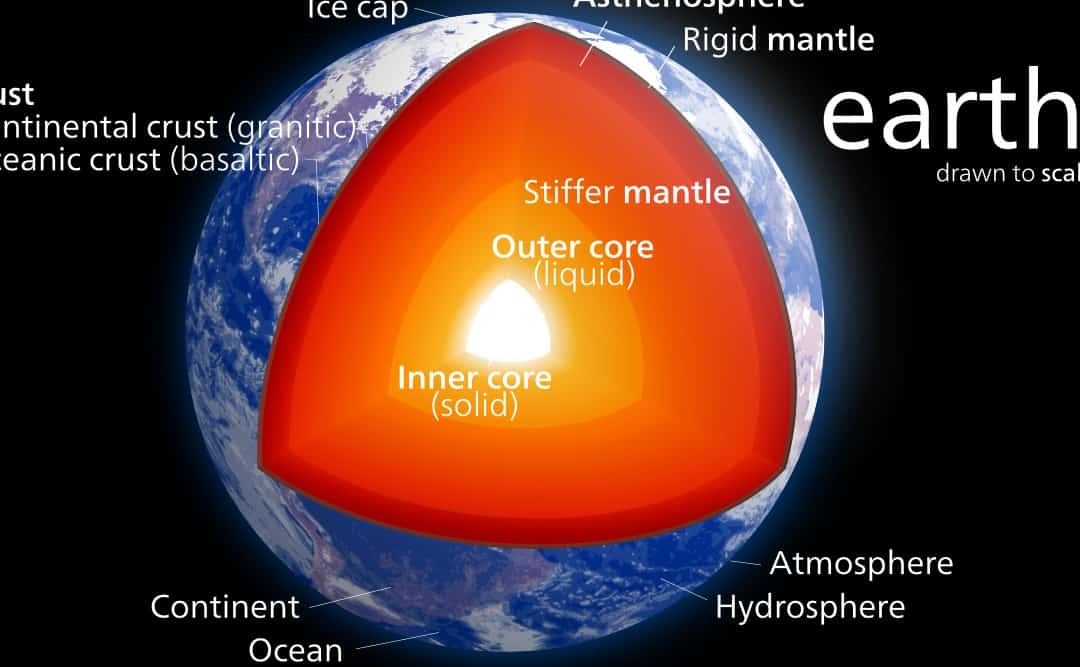Johansson, a distinguished member of the Royal Swedish Academy of Sciences and a retired professor at MISIS, is among the experts who propose that the core of our planet is composed of a crystal structure with a cubic lattice.
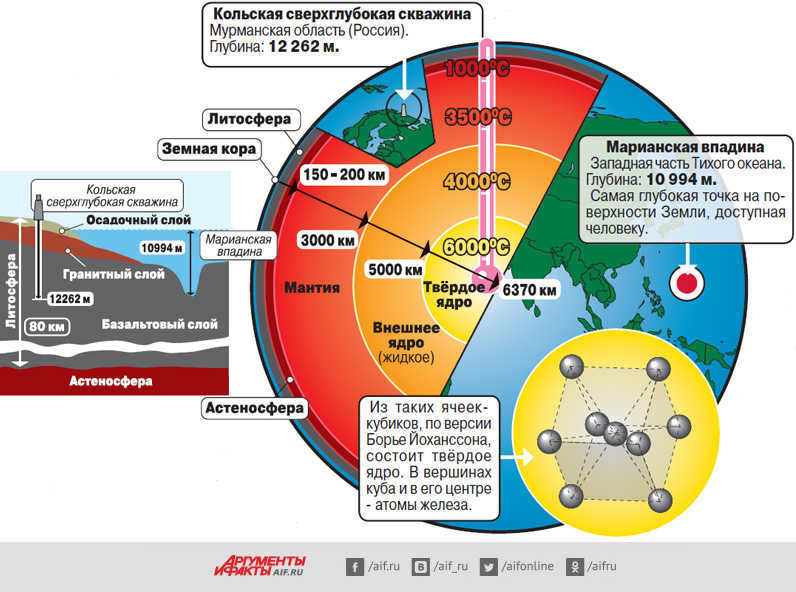
The Hidden Cubes
The existence of a core inside our planet was only discovered by scientists in the 20th century. Initially, it was believed that the core was in a liquid state. Then, a theory emerged suggesting that the matter inside was in an amorphous state. In 2005, it was finally proven that the core is solid, resembling a “ball,” and surrounded by a liquid core with a radius twice that of the Moon. The composition of the solid core, likely dominated by iron, and its internal structure still remain a mystery.

What benefits would we gain from this knowledge? One potential application is the ability to predict earthquakes. According to modern science, accurately predicting the time and location of the next earthquake is currently impossible. However, with the use of computer models that consider the influence of the Earth’s core structure on seismic activity, this may become feasible.
Another application lies in the data regarding the Earth’s magnetic field. For instance, the reliability of satellite communications and space systems, which are now heavily reliant on navigation, mineral exploration, weather forecasts, and the observation of natural phenomena, is greatly influenced by this data.

"Journey to the Center of the Earth"
Can we venture into the "core of the Earth"? Soviet geologists achieved this feat: the Kola ultra-deep well, which was initiated in 1970, delved into the Earth’s crust for over 12 kilometers. The drilling was intermittent but yielded valuable insights into the composition of the crust. It also sparked enigmatic tales. For instance, the Western media reported that "the Russians dug a well to hell": as the drillers encountered voids deep within the Earth, they lowered a microphone into the well, capturing eerie screams and moans.
There was also a concept considered for utilizing a targeted nuclear explosion in order to penetrate beneath the surface. Alternatively, a tungsten sphere containing nuclear fuel could be placed at the base of the well. Once the reaction occurs, the sphere would begin to liquefy the rock and, due to its own weight, descend towards the Earth’s core. If this probe is equipped with the necessary sensors and can establish communication (which is extremely challenging under these circumstances), it would transmit invaluable information about the composition of the planet.
Nevertheless, all of these projects remain within the realm of speculative fiction. The core of the Earth, on the other hand, is a tangible reality that still harbors numerous enigmas.
Techniques for Investigating the Internal Structure and Composition of the Earth
There are two main groups of methods for studying the internal structure and composition of the Earth: geological methods and geophysical methods. Geological methods rely on direct examination of rock strata in exposed formations, mine workings (such as mines and adits), and boreholes. These methods provide researchers with a wide range of techniques for studying structure and composition, resulting in highly detailed results. However, these methods have limited capabilities for studying the depths of the planet – the deepest well in the world, the Kola ultra-deep well in Russia, reaches a depth of only -12262 m. Even shallower depths have been reached through drilling on the ocean floor, with a maximum depth of about -1500 m achieved by the American research vessel “Glomar Challenger”. As a result, direct study is only possible at depths that do not exceed 0.19% of the planet’s radius.
The analysis of indirect data obtained through geophysical methods forms the basis for information on the deep structure. These methods primarily involve measuring the changes in various physical parameters (such as electrical conductivity and mechanical goodness of fit) at different depths during geophysical surveys. The development of models for the Earth’s internal structure relies heavily on seismic studies, which provide insights into the regularities of seismic wave propagation. Seismic waves, which are elastic vibrations, originate from earthquakes and powerful explosions. These waves can be categorized into volume waves that penetrate the planet’s interior like X-rays and surface waves that probe the upper layers of the planet to depths ranging from tens to hundreds of kilometers. Volumetric waves can be further classified into longitudinal waves and transverse waves. Longitudinal waves, also known as primary or P-waves, have a high propagation velocity and are the first to be detected by seismometers. On the other hand, transverse waves, referred to as secondary or S-waves, propagate at a slower speed and can only travel through a solid medium.
By examining the patterns of wave propagation, it becomes feasible to detect irregularities within the planet’s interior. If a sudden change in the velocities of seismic wave propagation, as well as their refraction and reflection, is observed at a certain depth, it suggests the presence of a boundary between the Earth’s inner layers that have distinct physical properties.
Earth’s Seismic Model
The exploration of seismic wave paths and velocities within the Earth’s interior has enabled the development of a comprehensive model depicting its internal structure.
As seismic waves propagate from earthquake sources into the depths of the Earth, they encounter significant changes in velocity, refracting and reflecting upon seismic sections situated at depths of 33 kilometers and 2900 kilometers beneath the Earth’s surface. These distinct seismic boundaries facilitate the division of the Earth’s interior into three primary geospheres: the crust, mantle, and core.
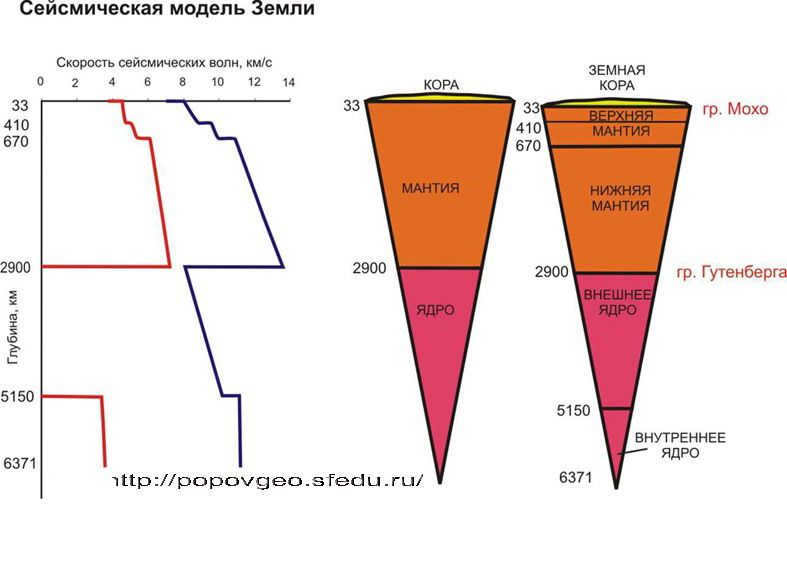
An even more distinct seismic boundary that separates the mantle and the core can be observed at a depth of 2900 km. 2900 km. At this particular point, the velocity of P-waves experiences a sudden change, jumping from 13.6 km/s at the base of the mantle to 8.1 km/s within the core. Simultaneously, the velocity of S-waves drops from 7.3 km/s to 0. The absence of transverse waves indicates that the outer region of the core possesses fluid-like properties. This seismic demarcation, which was discovered in 1914 by the German seismologist Gutenberg, is commonly known as the Gutenberg boundary. The Gutenberg boundary is not an officially recognized term, however.
Abrupt variations in wave velocity and characteristics occur at depths of 670 km and 5150 km. The boundary at 670 kilometers separates the mantle into two sections: the upper mantle (33-670 km) and the lower mantle (670-2900 km). Similarly, the 5150 kilometer boundary distinguishes the core into an outer liquid core (2900-5150 km) and an inner solid core (5150-6371 km).
Furthermore, significant changes are observed at the seismic section located at 410 km, which divides the upper mantle into two layers.
The data gathered on global seismic boundaries serve as the foundation for the modern seismic model of the Earth’s deep structure.
The development of the continental crust encompasses rocks of diverse geological ages, extending back to the most ancient rocks which date back approximately 4 billion years.
The oceanic crust, on the other hand, has a comparably thin composition, with an average thickness of 6-7 kilometers. In its most generalized form, it can be divided into two layers. The upper layer consists of sedimentary rocks, characterized by their relatively low thickness (averaging around 0.4 km) and low P-wave velocity (ranging from 1.6-2.5 km/s). The lower layer, known as the “basaltic” layer, is comprised of basic igneous rocks, with basalts found above and basic and ultrabasic intrusive rocks found below. The speed of longitudinal waves within this “basalt” layer increases from 3.4-6.2 km/s in basalts to 7-7.7 km/s in the deepest crustal horizons.
With regards to age, the oldest rocks within the modern oceanic crust are approximately 160 million years old.
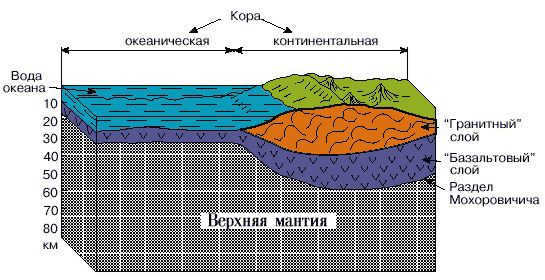
The Earth’s mantle is the largest inner layer of the Earth in terms of volume and mass. It is divided into two parts: the upper mantle and the lower mantle, which are separated by the 670 km boundary. The Moho boundary marks the upper boundary of the mantle, while the Gutenberg boundary marks its lower boundary.
The upper mantle is divided into two layers based on geophysical characteristics. The first layer, known as the subcrustal mantle, extends from the Moho boundary to depths of 50-80 km beneath the oceans and 200-300 km beneath the continents. It is characterized by a gradual increase in the velocity of longitudinal and transverse seismic waves, which can be attributed to the compaction of rocks under the lithostatic pressure from the overlying strata. Below the subcrustal mantle, there is a layer with reduced velocities that extends up to the global interface surface at 410 km. This layer, known as the asthenosphere, has lower seismic wave velocities compared to the subcrustal mantle. In certain areas, there are regions that do not transmit S-waves, suggesting that the mantle substance in these regions is partially molten. The term “asthenosphere” comes from the Greek words “asthenes” meaning weak and “sphair” meaning sphere. It was first introduced by the American geologist J. Burrell in 1914 and is sometimes referred to as the Low Velocity Zone (LVZ) in English-language literature. In summary, the asthenosphere is a layer in the upper mantle located approximately 100 km beneath the oceans and 200 km or more beneath the continents. It is characterized by decreased seismic wave velocities, reduced strength, and viscosity. The asthenosphere is also associated with a sharp decrease in resistivity to around 100 Ohm*m.
The presence of a flexible asthenospheric layer, which has different mechanical properties compared to the solid layers above it, provides a basis for distinguishing the lithosphere – the Earth’s solid shell that includes the Earth’s crust and the subcrustal mantle, situated above the asthenosphere. The lithosphere’s thickness ranges from 50 to 300 km. It is important to note that the lithosphere is not a uniform rocky shell of the planet, but is divided into separate plates that are constantly moving on the flexible asthenosphere. The epicenters of earthquakes and modern volcanic activity are concentrated along the boundaries of lithospheric plates. Below the 410 km zone, both P- and S-waves propagate uniformly throughout the upper mantle, and their velocity gradually increases with depth.
Within the lower mantle, there is a distinct global boundary at 670 km where the P- and S-wave velocities increase steadily without any abrupt changes. The P-wave velocity reaches 13.6 km/s while the S-wave velocity reaches 7.3 km/s, extending until the Gutenberg section.
As we move into the outer core, the P-wave velocity sharply drops to 8 km/s and the S-waves completely vanish. This suggests that the Earth’s outer core exists in a liquid state. However, below the 5150 km section, there is an inner core where the P-wave velocity starts to increase again and the S-waves resume propagation, indicating its solid state.
Based on the velocity model described above, it can be concluded that the Earth is composed of concentric shells consisting of a ferruginous core, silicate mantle, and aluminosilicate crust.
Geophysical study of the Earth’s properties
Allocation of mass within the internal geospheres

The Earth’s mass is mainly composed of its mantle, which makes up about 68% of its total mass. The lower mantle accounts for approximately 50% of the Earth’s mass, while the upper mantle makes up about 18%. The core contributes to the remaining 32% of the Earth’s mass, with its liquid outer part being much heavier than the solid inner part. The liquid outer core makes up about 29% of the Earth’s total mass, while the solid inner core only accounts for about 2%. The crust, on the other hand, represents less than 1% of the planet’s total mass.
The density of the Earth’s shells naturally increases as you move towards the center. The crust has an average density of 2.67 g/cm3, but at the Moho boundary, it jumps to a range of 2.9-3.0 g/cm3 to 3.1-3.5 g/cm3. In the mantle, the density gradually increases due to the compression of silicate matter and phase transitions. It goes from 3.3 g/cm3 in the subcrustal part to 5.5 g/cm3 at the bottom of the lower mantle. At the Gutenberg boundary (2900 km), the density jumps almost twofold to 10 g/cm3 in the outer core. Another density jump occurs at the boundary between the inner and outer core (5150 km), where the density changes from 11.4 to 13.8 g/cm3. These two sharp density jumps have different causes: the mantle/core boundary experiences a change in chemical composition from silicate mantle to iron core, while the jump at the 5150 km boundary is associated with a change in the state of matter from liquid outer core to solid inner core. At the center of the Earth, the density of matter reaches 14.3 g/cm3.
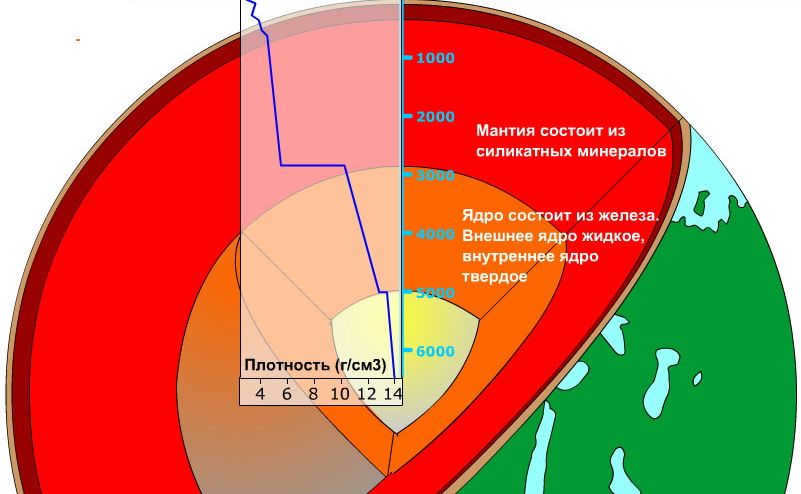
Pressure
The calculation of pressure in the Earth’s interior is based on its density model. The increase in pressure as one moves away from the surface is attributed to various factors:
- Compression resulting from the weight of overlying layers (lithostatic pressure);
- Phase transitions occurring in chemically uniform layers (particularly in the mantle);
- Variations in the chemical composition between layers (such as the crust and mantle, or the mantle and core).
At the lowermost part of the continental crust, the pressure measures approximately 1 GPa (or more accurately, 0.9*10 9 Pa). As we descend into the Earth’s mantle, the pressure gradually rises, eventually reaching 135 GPa at the Gutenberg boundary. Moving further towards the outer core, the rate of pressure increase becomes steeper, while in the inner core, it actually starts to decrease. The estimated pressure values at the boundary separating the inner and outer cores, as well as near the Earth’s center, are 340 and 360 GPa, correspondingly.
Temperature: Generating Thermal Energy

The lithosphere primarily experiences conductive heat transfer, while the sublithospheric mantle of the Earth undergoes a transition towards a predominantly convective mechanism of heat transfer.
Calculations of temperature within the Earth’s interior yield the following results: at a depth of approximately 100 km in the lithosphere, the temperature measures around 1300°C; at a depth of 410 km, the temperature rises to 1500°C; at 670 km, the temperature reaches 1800°C; at the core-mantle boundary, it peaks at 2500°C; at 5150 km, the temperature climbs to 3300°C, and at the center of the Earth, it peaks at 3400°C. The temperature of the mantle within the Earth was only calculated for the lithosphere, and it solely accounted for the primary heat source – the energy generated by deep gravitational differentiation in deep zones.
At the planetary surface, the primary external heat source is solar radiation. However, as we delve deeper below the surface, the impact of solar heat diminishes significantly. In fact, at relatively shallow depths (around 20-30 m), we encounter a region with constant temperatures. This depth zone exhibits a consistent temperature, which aligns with the average annual temperature of the surrounding area. Below this zone, heat is derived from internal sources.
The Earth possesses a colossal magnetic field with magnetic poles that are not exactly aligned with the geographic poles. Consequently, when using a magnetic compass, it is essential to differentiate between magnetic declination and magnetic inclination.
Magnetic declination refers to the angle between the direction indicated by the magnetic compass and the geographic meridian at a specific location. This angle is most significant at the poles (reaching up to 90°) and least substantial at the equator (around 7-8°).
Magnetic inclination, on the other hand, represents the angle formed by the tilt of the magnetic compass in relation to the horizon. As one approaches the magnetic pole, the compass needle will become more vertical in position.
When I was a kid, I used to love reading stories about exploring the depths of the Earth. Exploring the center of the Earth seemed like such an exciting adventure. Looking back, it’s amusing to think about how I enthusiastically dug a hole in my grandma’s backyard, hoping to uncover something extraordinary. Unfortunately, all I found were a few old tin cans, far from reaching the Earth’s core 🙂

What Lies at the Core of the Earth
The question of what lies at the core of the Earth has long intrigued humanity. However, a definitive answer remains elusive. Scientists have proposed various theories, assumptions, and hypotheses, but no consensus has been reached. Currently, the prevailing theory suggests that the Earth’s core consists of a dense metallic center enveloped by molten magma. Contemporary scientific understanding identifies two distinct components within the core: a liquid outer core and a solid inner core.
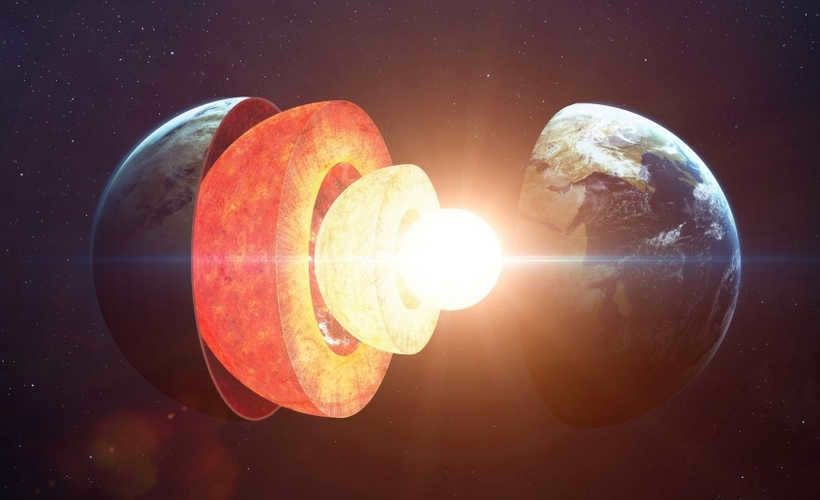
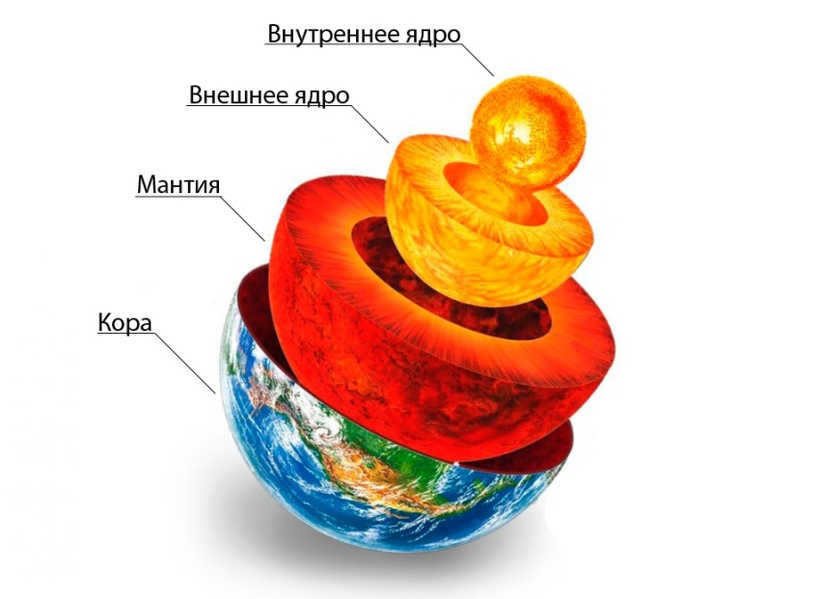
Using the methods described above, scientists have successfully categorized the planet into the following layers:
By combining all of the collected data, contemporary science proposes that the central region is composed of the geosphere, potentially comprised of a blend of nickel and iron, with trace amounts of other elements. The geosphere extends to a depth of 3,000 kilometers, and the average radius of the shell may reach up to 3,500 kilometers.
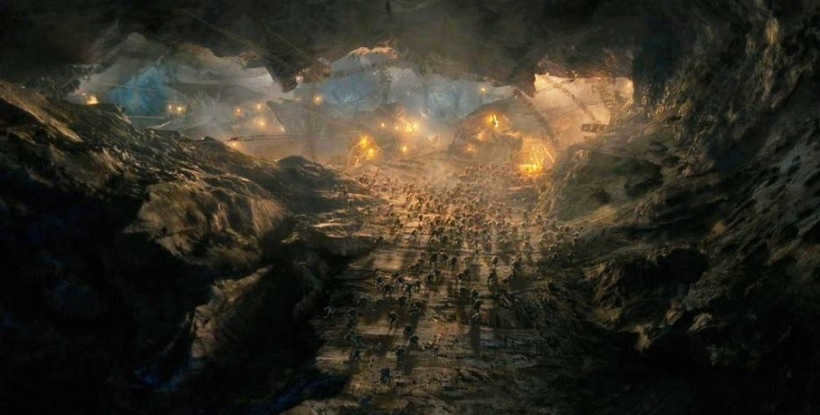
A Different Society.
Some scientists in the present day are proposing with great seriousness that there are empty spaces within the Earth. Moreover, going even further, it has been suggested that there exists an “inner sun”, as well as plant life, animal life, and even a society. According to this hypothesis, there are entrances to this subterranean world located at the Earth’s poles. subterranean world..
In my opinion, the theory that the core of the Earth is a glowing ball called the center is the most credible. Currently, there is no direct way to confirm what truly exists at the Earth’s center due to the depth of an ultra-deep borehole being only about 0.3% of the distance to the core. This limitation arises from the extreme temperature close to the core, estimated to be around 6000 °C, surpassing the capabilities of any available instrument. Therefore, all the information provided here regarding the temperature, composition, and state of the Earth’s center is based on estimates.
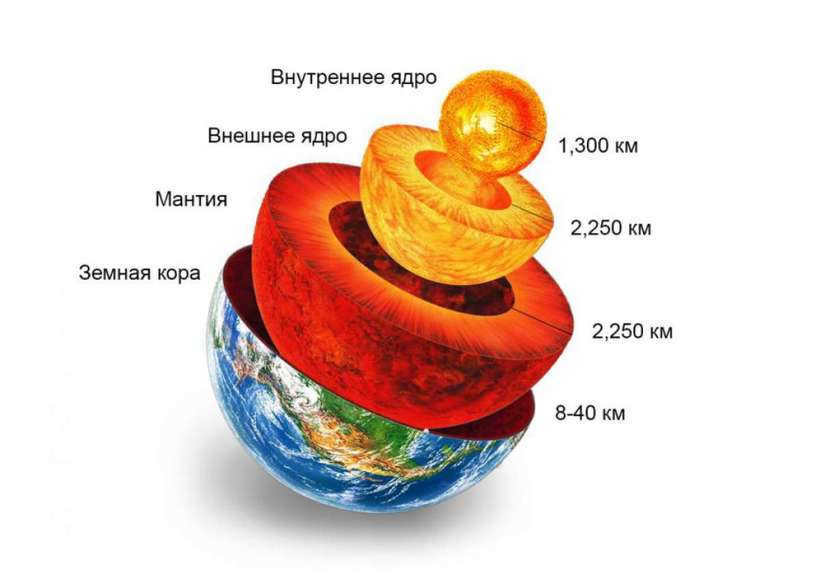
The heat at the core of the Earth
The temperature in the core remains exceptionally high due to:
- The breakdown of radioactive substances.
- Gravitational energy.
- Chemical reactions and changes in state.
In my opinion, the second factor is the primary source of heat, as it is sufficient on its own to prevent the core from cooling for billions of years to come.
The condition of substance in the Earth’s center
Given the presence of the Earth’s magnetic field, it stands to reason that there exists a substance akin to a perpetual magnet within its core.
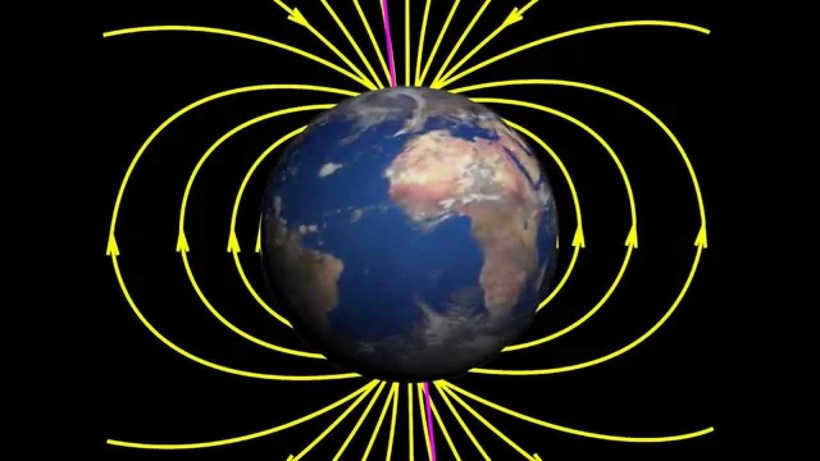
Despite having a similar composition to the outer core, the inner core is still believed to have a solid structure due to the immense pressure it experiences.
The composition of Earth’s core
The core is primarily composed of iron, similar to iron meteorites. However, studies have shown that the density of the core is approximately 5-10% lower, indicating the presence of lighter elements such as sulfur, oxygen, silicon, carbon, phosphorus, and hydrogen.

Once, I embarked on a journey across the vast Pacific Ocean. During this extraordinary expedition, our vessel found itself positioned directly above the Mariana Trench, which happens to be the deepest point on our entire planet. To put it into perspective, Mount Everest could be completely submerged within its depths, with roughly three kilometers of water still towering above it. As I gazed over the edge of the ship, I couldn’t help but wonder about the mysteries concealed even deeper within the Earth’s core.
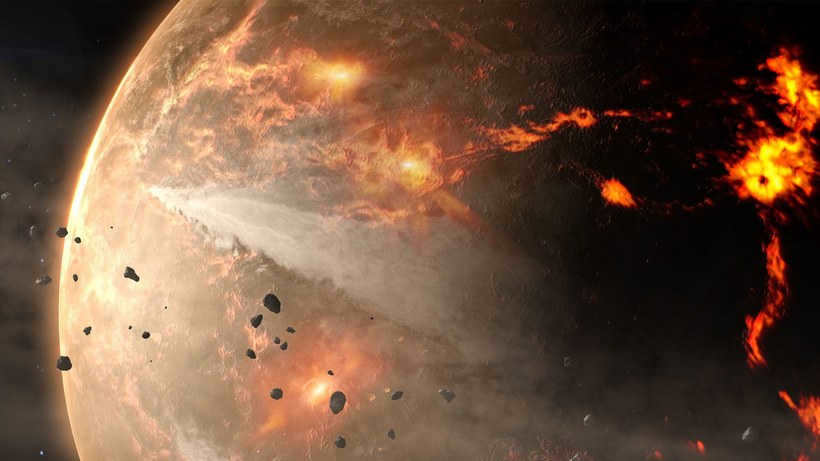
Take a Leap to the Core of the Earth
A documentary film has left an indelible impression on me, delving into the depths of this topic. It envisions the astonishing sights a person would encounter while plunging into a chasm leading straight to the core of our planet.
Initially, the intrepid explorer would have to traverse a formidable 65-kilometer layer known as the crust. Next, they would venture through the mantle, spanning an astonishing distance of nearly 3,000 kilometers. Finally, the thrilling phase would commence as they reach the heart of the Earth and its surrounding environs.
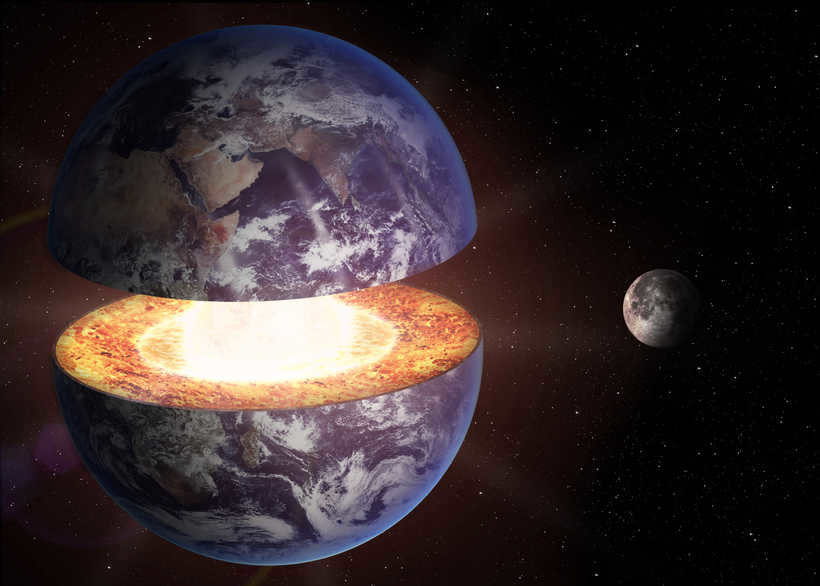
What Lies at the Depths of the Earth
To the best of my knowledge, scientists obtain all the information regarding the interior of our planet through calculations of its density and observations of seismic activity occurring in various regions of the Earth.
Consequently, they have determined that the outer core is the first layer, with a radius of 3,400 kilometers. This layer consists of various substances, including:
The temperature within this region ranges from 4,400 to 6,100 degrees Celsius. It is this core that generates the Earth’s powerful magnetic field.
Next, we have the central nucleus. This region is primarily composed of iron and nickel alloys, and the temperature reaches a staggering six thousand degrees. The immense pressure contributes to its incredible hardness. In fact, the density of iron atoms in this area is nearly double that of the Earth’s surface. Such is the toughness of the core that seismic waves actually bounce off it during an earthquake, resulting in extra tremors on the surface. However, it is precisely due to its high density that the Earth maintains a pleasant gravitational pull, essential for sustaining life.
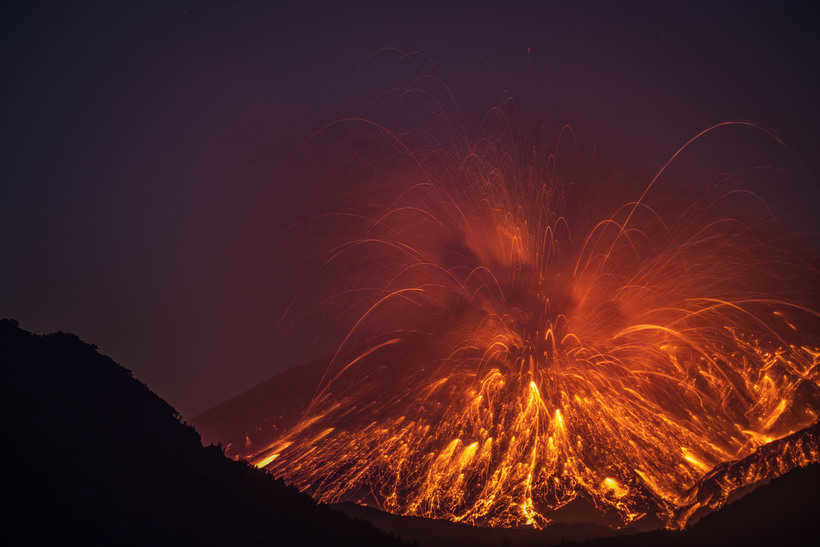
It appears that the Earth’s core, although inaccessible to us earthlings, has a profound impact on our existence. It generates a magnetic field that shields us from deadly cosmic radiation and keeps us firmly grounded, preventing us from floating off into space with a single leap!
While on vacation, I used to enjoy diving and exploring the mesmerizing wonders of the underwater world. The depths of the Mediterranean Sea captivated me. After one particular dive, it got me thinking – if the lower water columns of the seas and oceans are so challenging for humans to conquer, one can only imagine the untapped depths of the Earth’s interior.
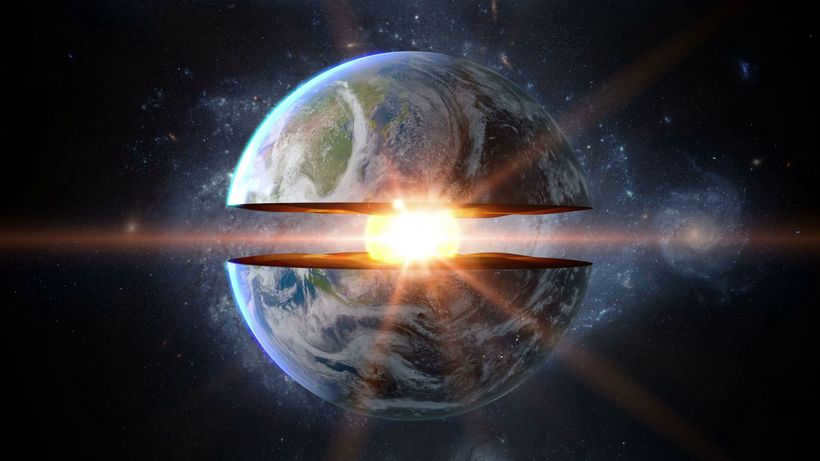
Exploring the History of Earth
Throughout history, humans have made incredible advancements in technology, allowing us to dive into the deepest parts of the ocean, venture into space, and explore the vastness of the universe. However, one thing still eludes us – the center of the Earth. This is understandable, as reaching the Earth’s core would require an immense amount of time and effort, considering it is approximately 6371 kilometers deep. Even with unwavering enthusiasm and the most advanced tools, it remains an impossible feat.
There have been a few brave attempts to uncover the secrets of the Earth’s composition from within:
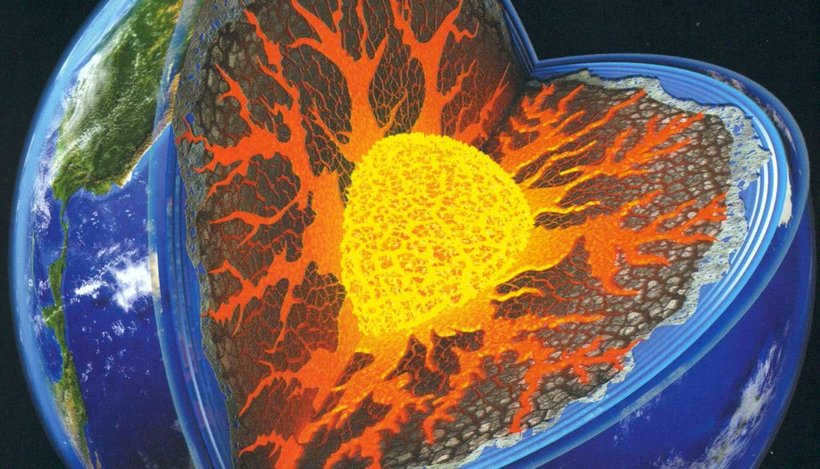
- The experiment was stopped when super-hot sulphur was released at a depth of 9 kilometers.
- A drilling rig was destroyed when a powerful flow of oil and gas burst from the Earth’s depths at a depth of 7 km.
- The Kola well, which is the deepest on Earth at a depth of 12 km, was abandoned during the USSR.
Journey to the “center” of the Earth
If one were to excavate a tunnel that traverses the entire globe, the descent to the center of the Earth could be completed in a mere 18 minutes of free fall. Within the first minute, the digger would penetrate the Earth’s crust – the uppermost layer of our planet, which measures a substantial 45 kilometers in thickness across landmasses. Following this, entry into the mantle, the largest component of our planet, would ensue. Comprising a staggering 82% of the Earth’s overall volume, the descent to the lower boundary of the mantle would require an additional 10 minutes. Once the digger reaches this point, they would be thrust into the outer core – a region consisting of scorching liquid metal with temperatures reaching a blistering 5,000 °C (5,000 °F). This liquid and incredibly hot environment would encompass the next 2,000 kilometers of the journey.
It is worth noting that the core exerts a substantial influence on various aspects of our planet, including the growth patterns of average annual temperatures, the rate at which the Earth rotates, and the generation of the magnetic field.
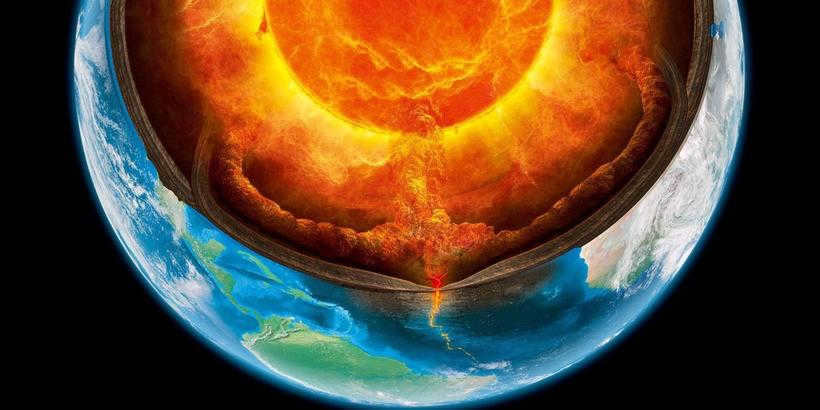
After eight minutes of descending, they would arrive at the most guarded secret of our planet. This enigma is a compact sphere made of iron and nickel, with a temperature equivalent to the surface of the Sun. It stands as the most peculiar entity ever encountered by science. Unraveling the mysteries of the core proves to be challenging. However, innovative techniques are currently under development to detect faint seismic waves that traverse through the inner core.
The realm of science has always captivated me. Initially, it seemed like the ultimate solution to all inquiries. Nevertheless, as I matured, I came to the realization that this notion was far from accurate. Yet, my fascination with science remains intact. In fact, the unresolved enigmas of the cosmos ignite an even greater interest within me.
One of these mysteries is the composition at the heart of our planet.
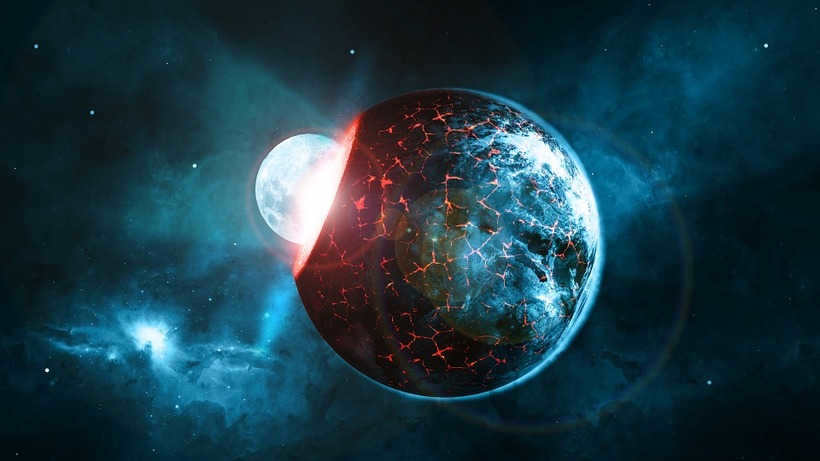
Subterranean and Beyond
Eyes, as you are aware, serve as windows into the soul. However, the “window” into the Earth’s core can be considered as the mantle and to a somewhat lesser extent, lithospheric plates.
It is through the examination of these elements that we are able to formulate various hypotheses regarding the contents of the Earth’s center.
Scientists possess knowledge pertaining to the composition and dimensions of the lithospheric plates.
Additionally, the composition and structure of the Earth’s mantle are also widely comprehended. By means of drilling and the investigation of volcanic emissions, we are able to observe it from a close proximity.
However, what lies further beneath remains uncertain.

Despite the fact that this question is of great interest to scientists, and information about the content of the Earth’s innermost region is still available, albeit incomplete.
Approaches to investigating the Earth’s central region:
A notable example of a comparative approach is the examination of meteoriteswhich are fragments from the cores of asteroids and protoplanets.
Years of scientific research have provided approximate data on the dimensions, temperature, and makeup of the central part.
Discovering the Secrets of the Earth’s Core
It is a commonly known fact that the center of our planet is incredibly hot. The intense heat at the core is what gives our planet its unique characteristics. However, the specifics of the core’s composition remain a mystery that can only be speculated upon.
Based on current knowledge, scientists believe that the core is situated approximately 2,900 kilometers beneath the Earth’s surface. It is divided into two distinct parts: the outer core and the inner core, each playing a crucial role in the dynamics of our planet.
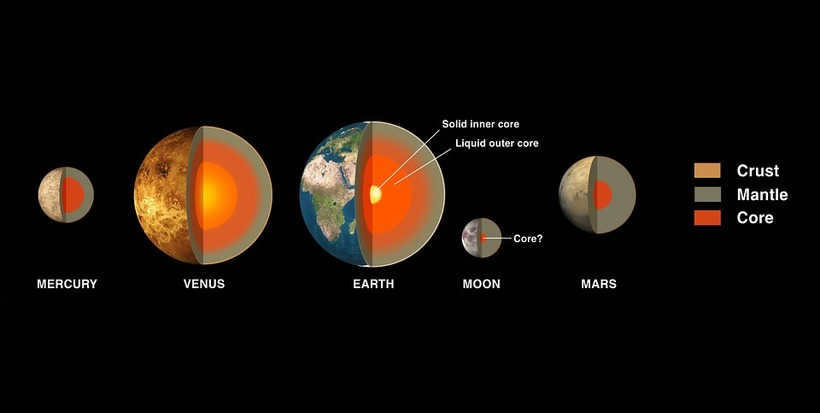
The external core is extremely hot and liquid. The precise composition remains speculative, but the primary constituent is believed to be iron. It also contains traces of sulfur and oxygen.
The internal core is solid. This is due to the higher pressure it experiences compared to the external core. It is believed to be predominantly composed of iron and nickel.
However, these are mere conjectures, as no samples from either the external or internal core have been obtained thus far. Nevertheless, I have faith in the progress of science, and I am confident that someday this enigma will be unraveled. And new mysteries will arise in its place.
I am also intrigued by the enigmas of our planet! However, it is unfortunate that the solutions are not always accurate, leading to even more inquiries!
Exploring the composition of the world can be incredibly captivating. Some individuals spend their nights gazing up at the starry sky, while others strive to comprehend what lies beneath their very feet. I firmly believe that it is essential to investigate the world around us from all angles, as this is the only way to gain a true understanding of the universe. The question of what occupies the core of the Earth has been a subject of debate for centuries, evolving alongside human civilization. New findings have emerged, which have now been meticulously organized and made accessible to the public.
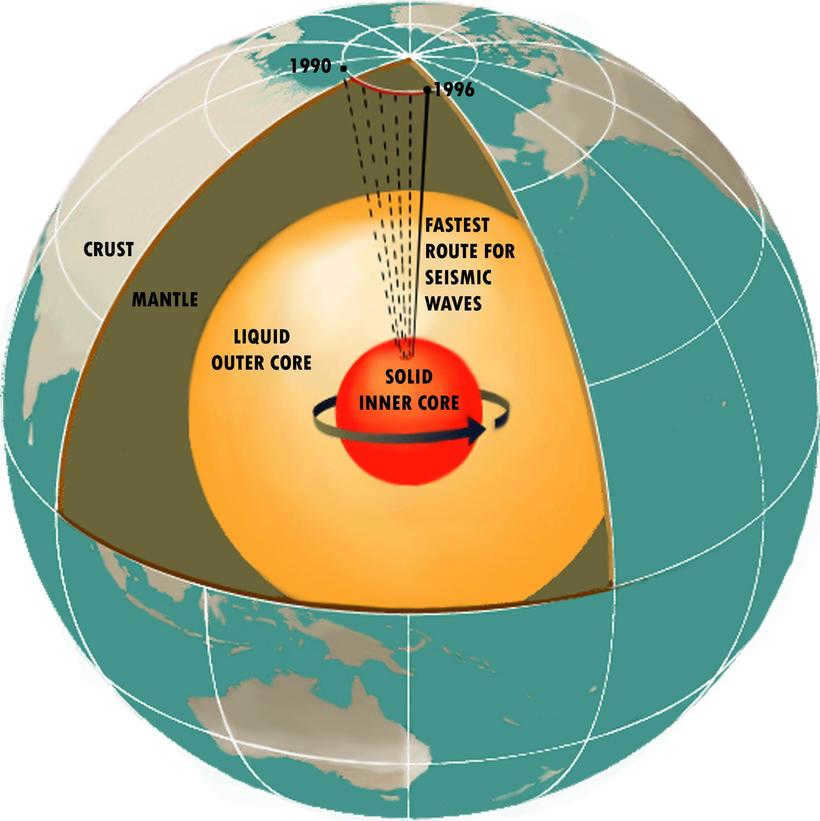
Composition of the Earth’s Core
Although there are numerous hypotheses and theories, it is still premature to discuss their credibility. It is currently impossible for humans to reach the Earth’s core as even the most advanced equipment lacks the necessary specifications. In this regard, the practical examination of specific phenomena has played a significant role, such as:
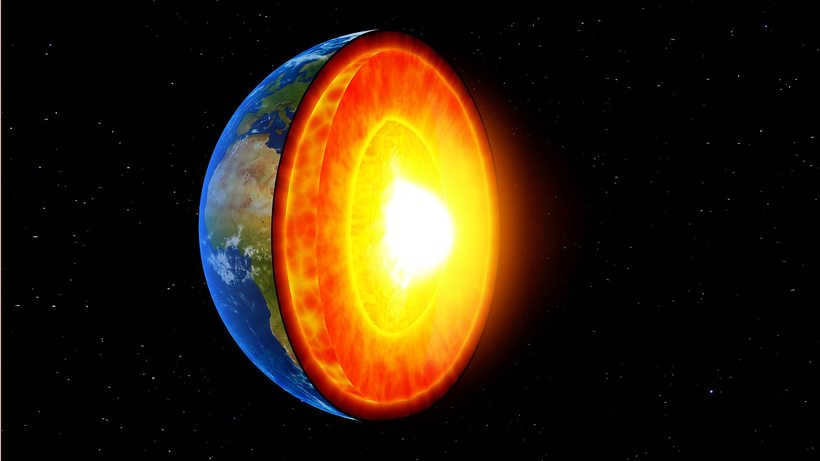
- Volcanic eruptions.
- Tectonic shifts.
- Ground vibrations.
Mankind has gained the understanding that deep within the planet, there exist extremely high temperatures. The investigation of seismic activities has facilitated the examination of earthquakes, as the molten rock expelled during a volcanic eruption reaches a scorching hot state. The analysis of seismic activities has enabled the recording of seismic waves, which, similar to X-rays, penetrate into the depths of the Earth. Using highly sensitive instruments, scientists draw conclusions from these waves. The amplitude of these waves can either amplify or diminish, depending on the depth at which they are observed. Consequently, we have been able to ascertain that the uppermost layer is known as the crust, followed by the mantle, and finally, at the greatest depth, the core, which consists of liquid iron and nickel.
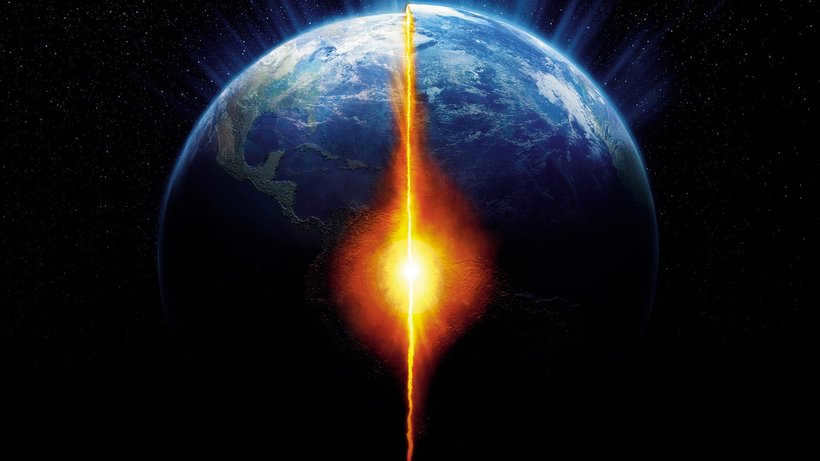
Different Composition of Planets
Not all planets in our solar system have the same composition. For instance, Jupiter, Saturn, Uranus, and Neptune are gas giants, which means that they have a core. However, they differ substantially from the terrestrial planets in various other aspects. Furthermore, the core of Uranus emits minimal heat, suggesting that it is unlikely to be extremely hot.
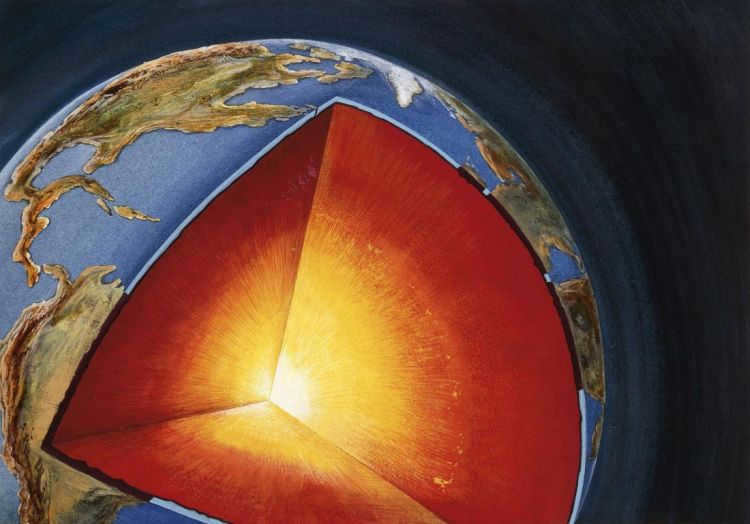
Human beings have successfully explored various parts of the Earth, from its lands to its skies and even its deep oceans. Our achievements have taken us to outer space and even to the moon. However, despite these incredible accomplishments, no human has ever reached the core of our planet.
We have yet to reach proximity. The Earth’s core is situated 6,000 kilometers beneath its surface, with the outer section of the core extending a further 3,000 kilometers below human habitation. The deepest man-made well, located in Russia, reaches a depth of approximately 12.3 kilometers.

Most significant occurrences on our planet take place near its surface. The molten lava that erupts from volcanoes turns to liquid at a depth of a few hundred kilometers. Even precious diamonds, which require intense heat and pressure to form, originate from a depth of 500 kilometers.
What lies beneath remains shrouded in enigma. It appears unfathomable. However, we have managed to acquire a remarkable amount of knowledge about the Earth’s core. Scientists have even formulated some theories about its formation billions of years ago, all without a single tangible sample. But how did they uncover this information?
The Earth’s Mass
One way to conceptualize the mass of our planet is to consider its gravitational influence on objects situated on its surface. By observing this effect, we can estimate that the Earth has a mass of approximately 5.9 sextillion tons, which is equivalent to the number 59 followed by 20 zeros. It is remarkable that there is no visible indication of such a colossal mass on the Earth’s surface.
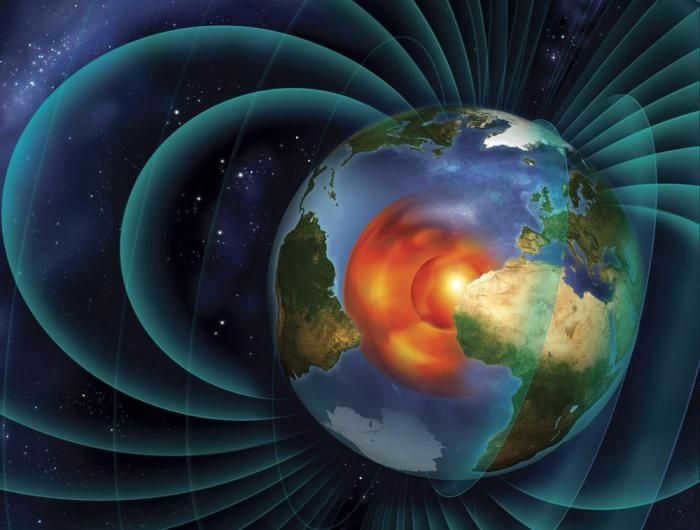
The average density of materials found on the Earth’s surface is significantly lower compared to the overall density of the planet. This suggests the presence of a highly dense substance within its core.
Furthermore, the majority of the Earth’s mass is believed to be concentrated towards its center. Consequently, further investigation is required to determine the specific heavy metals that constitute its core.
According to scientists, iron is believed to make up the majority of the Earth’s core, accounting for approximately 80% of its composition, although the exact percentage is still a subject of debate.
The primary evidence supporting this theory is the abundance of iron in the universe. Iron is considered one of the top ten most plentiful elements in our galaxy and is frequently found in meteorites. Given its prevalence, it is surprising that iron is relatively scarce on the Earth’s surface. This has led to the hypothesis that during the Earth’s formation approximately 4.5 billion years ago, a significant portion of the iron migrated to the core.
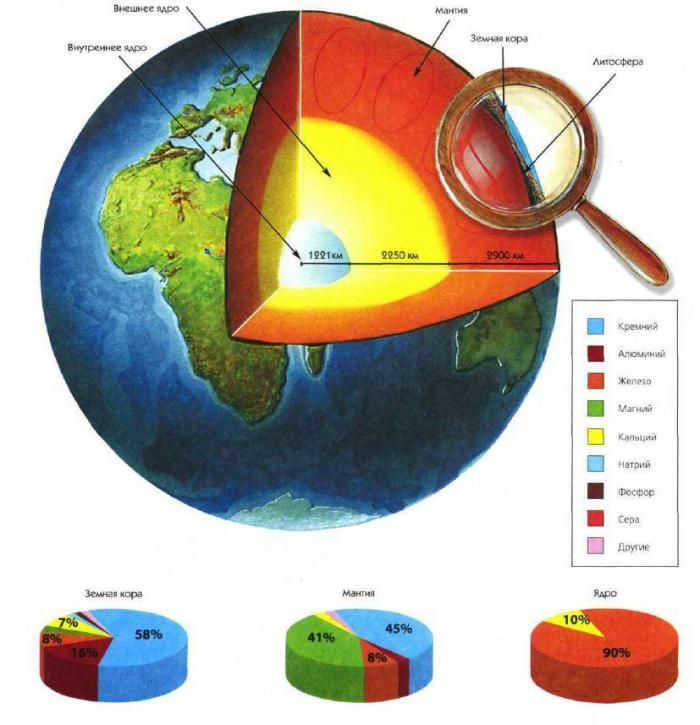
This is the reason why the Earth’s core comprises the majority of the planet’s mass and contains most of its iron. Iron is a naturally dense element, and due to the extreme pressure at the Earth’s center, its density is even higher. As a result, the iron core is responsible for the entirety of this mass not reaching the Earth’s surface. However, the question arises: how is it possible for the majority of the iron to be concentrated in the core?
The mysteries of the Earth’s core formation
The process by which iron ended up at the center of the Earth remains a enigma. It is not immediately clear how this phenomenon occurred.
The majority of the Earth’s mass consists of silicate rocks, and molten iron attempts to penetrate through them. Similar to how water forms droplets on a greasy surface, iron accumulates in small reservoirs where it cannot disperse or be depleted.
Scientists at Stanford University in California, USA, made a groundbreaking discovery in 2013. They conducted experiments to investigate the effects of intense pressure on iron and silicate, similar to the conditions that existed at the Earth’s core. By using diamonds to apply pressure, they were able to observe the interaction between molten iron and silicates. The results showed that at higher pressures, a molten network was formed. This suggests that over billions of years, the iron gradually descended through the rock layers until it reached the core.
Another point of curiosity might be how scientists determine the dimensions of the core. What leads them to believe that it is situated approximately 3000 kilometers beneath the surface. The solution lies within the field of seismology.
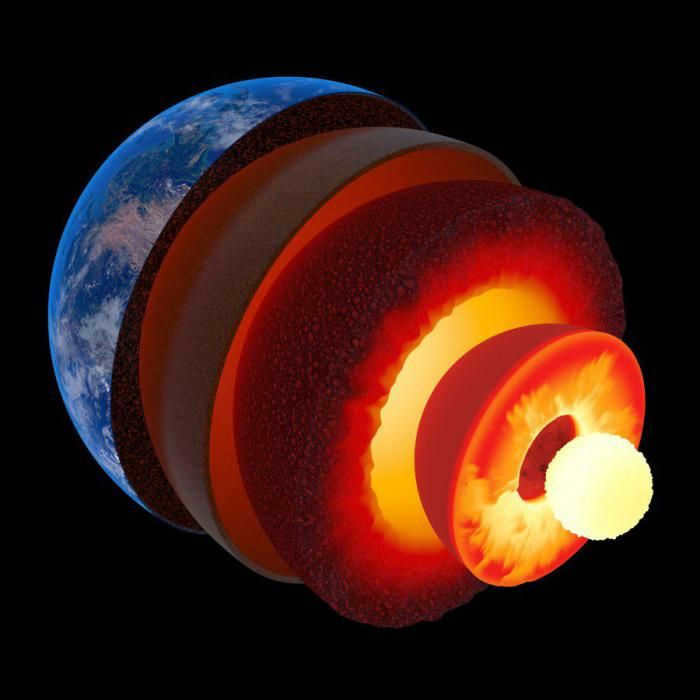
During an earthquake, seismic waves propagate throughout the globe. These vibrations are recorded by seismologists, who liken the process to striking one side of the Earth with a colossal hammer and listening to the resulting noise on the opposite side.
The Chile earthquake of 1960 yielded an extensive amount of data. Seismological stations worldwide were able to capture the tremors caused by this seismic event. The path these vibrations take as they traverse the Earth’s various regions affects how they are perceived in other locations, giving them a unique “sound”.
During the early stages of seismology, it became evident that certain vibrations were disappearing. The anticipated appearance of S-waves on the opposite side of the globe never materialized. The explanation for this phenomenon was rather straightforward. S-waves were only able to reflect off solid materials and were unable to do so through liquids. As a result, they had to traverse through a molten substance located at the Earth’s core. By analyzing the paths of the S-waves, it was discovered that solid rock transitions into a liquid state approximately 3000 kilometers below the surface. This revelation indicated that the Earth’s core possessed a liquid composition. However, seismologists were in for another unexpected revelation.
The composition of the Earth’s core
In 1930, Inge Lehmann, a seismologist from Denmark, made an observation that led to the discovery of the Earth’s core structure. She noticed that a different type of wave, known as P-waves, could travel through the core and be detected on the opposite side of the planet. This led scientists to conclude that the core is made up of two layers. The inner layer, starting at a depth of approximately 5,000 kilometers from the surface, is composed of solid matter. On the other hand, the outer layer exists in a liquid state. This hypothesis was later confirmed in 1970 when more advanced seismographs revealed that P-waves could indeed penetrate the core and, in certain cases, change direction away from it. Despite this, the waves could still be detected on the opposite side of the planet.
Stay up to date with the latest news and articles by subscribing to the UFO WORLD telegram channel. Receive instant notifications on your phone.
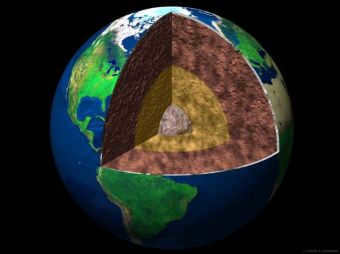
The Core of the Earth
The central region of the Earth, known as the core, is situated at a depth of 2900 km or more. The core constitutes approximately 31% of the Earth’s total mass and occupies around 16% of its volume. These proportions indicate that the core is composed of exceptionally dense and heavy materials, likely an alloy of nickel and iron.
Research suggests that the density of the core is not uniform, with its outer layers existing in a liquid state while the inner part remains solid. This discrepancy in state is due to the immense pressure exerted on the core. Varying sources provide different estimations for the temperature of the Earth’s core, ranging from 4000 to 7000 degrees Celsius.
Methods of Research
Indirect methods are employed to conduct studies on the Earth’s core as it is not feasible to obtain samples of the substance found within the planet. Advanced technology allows penetration of only up to 12 kilometers into the planet. To gain insight into the activities occurring at the Earth’s core, scientists analyze seismic waves. Seismic stations have been established across various locations on the planet to record the vibrations of the Earth’s crust during seismic events.
Scientists also investigate fragments of asteroids that arrive on Earth from outer space. Studies indicate that asteroids are made up of iron-nickel alloys, leading geophysicists to deduce that the core of the Earth might also consist of a similar alloy. Nevertheless, some scientists contend that there are alternative, less dense chemical elements at the heart of the planet. The metallic “foundation” of the Earth, along with its rotation, is responsible for generating the magnetic field.
Scientific and quasi-scientific hypotheses
Throughout different periods, diverse scientists have proposed their hypotheses concerning the structure of the Earth. The traditional hypothesis put forth by American explorers Reed and Reid was well received by geologists and mineralogists, but received criticism from those who had witnessed drilling to depths exceeding 7 km. In educational institutions, students are instructed that the planet’s interior consists of a core composed of iron-nickel alloy, whereas in higher education, professors elaborate on this by stating that nuclear reactions are continuously transpiring within the core.

